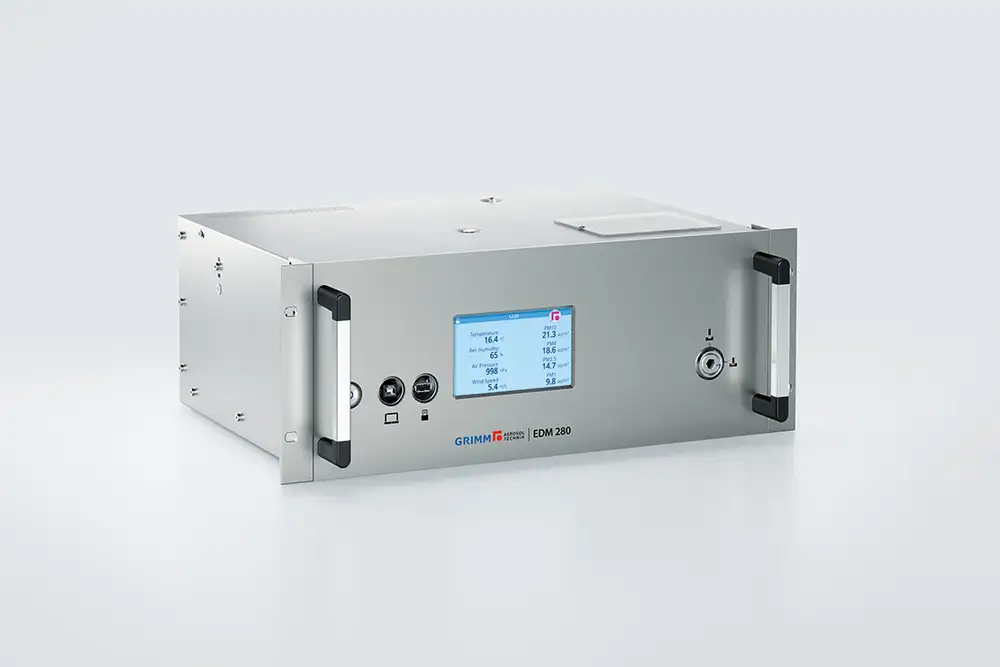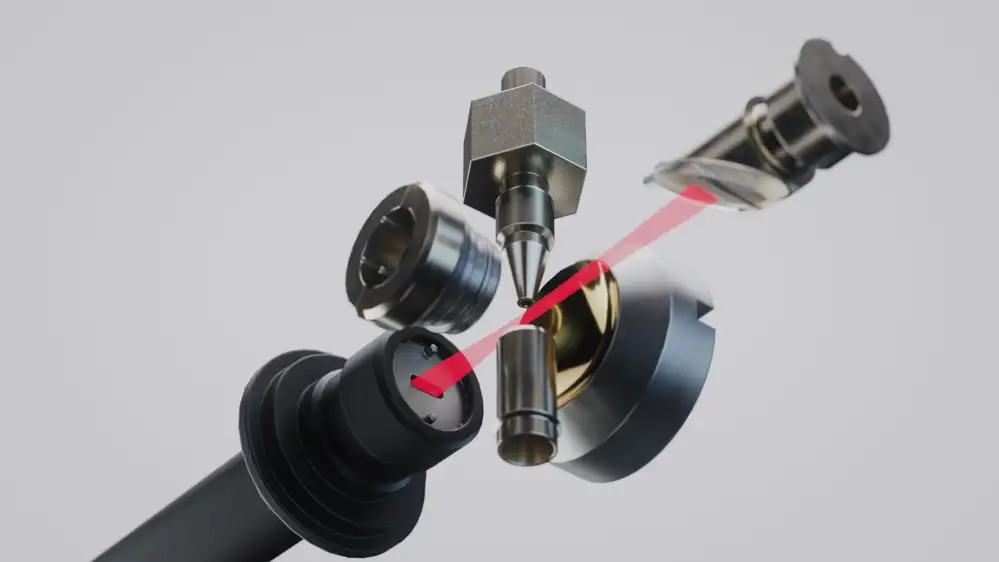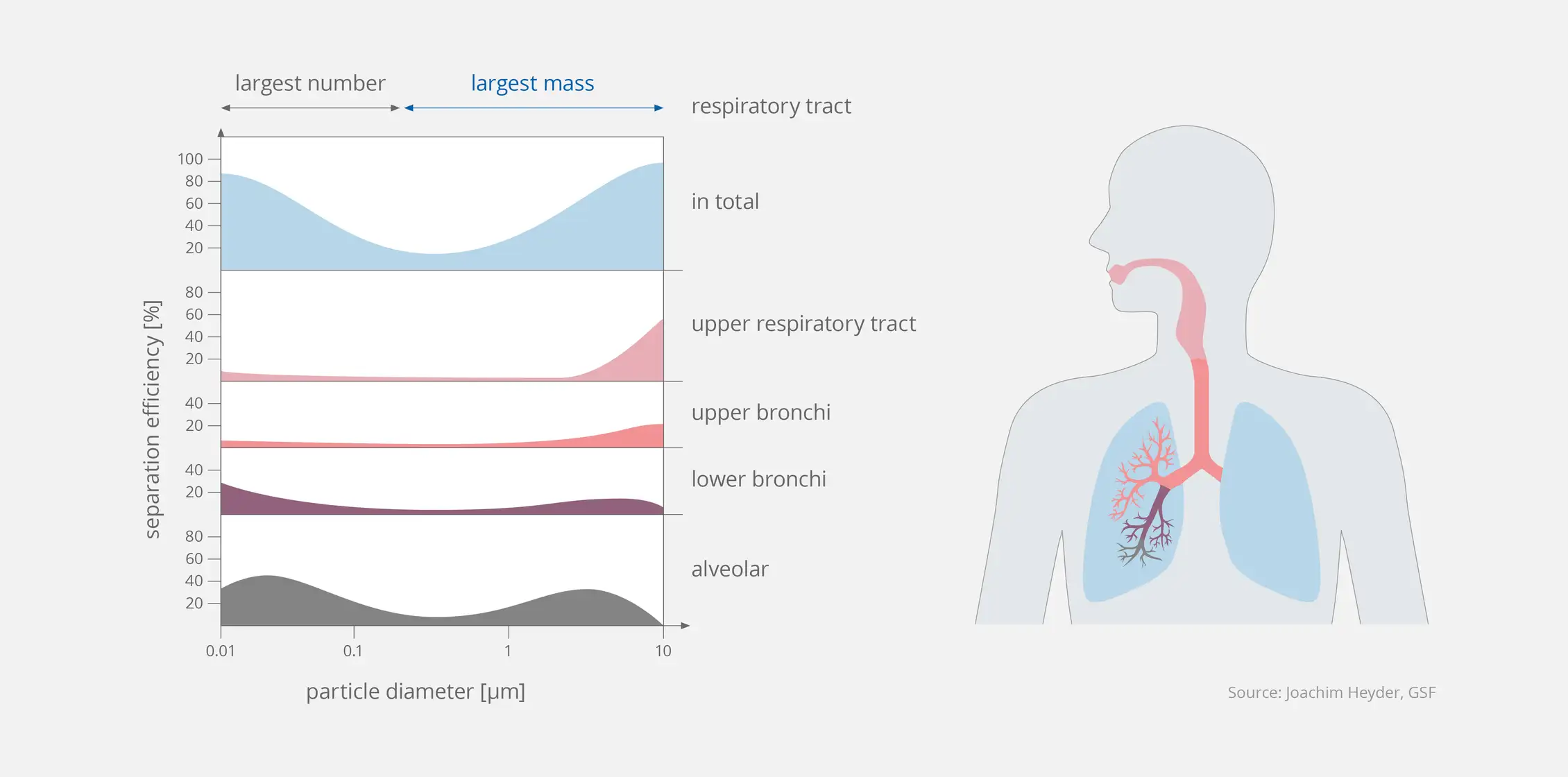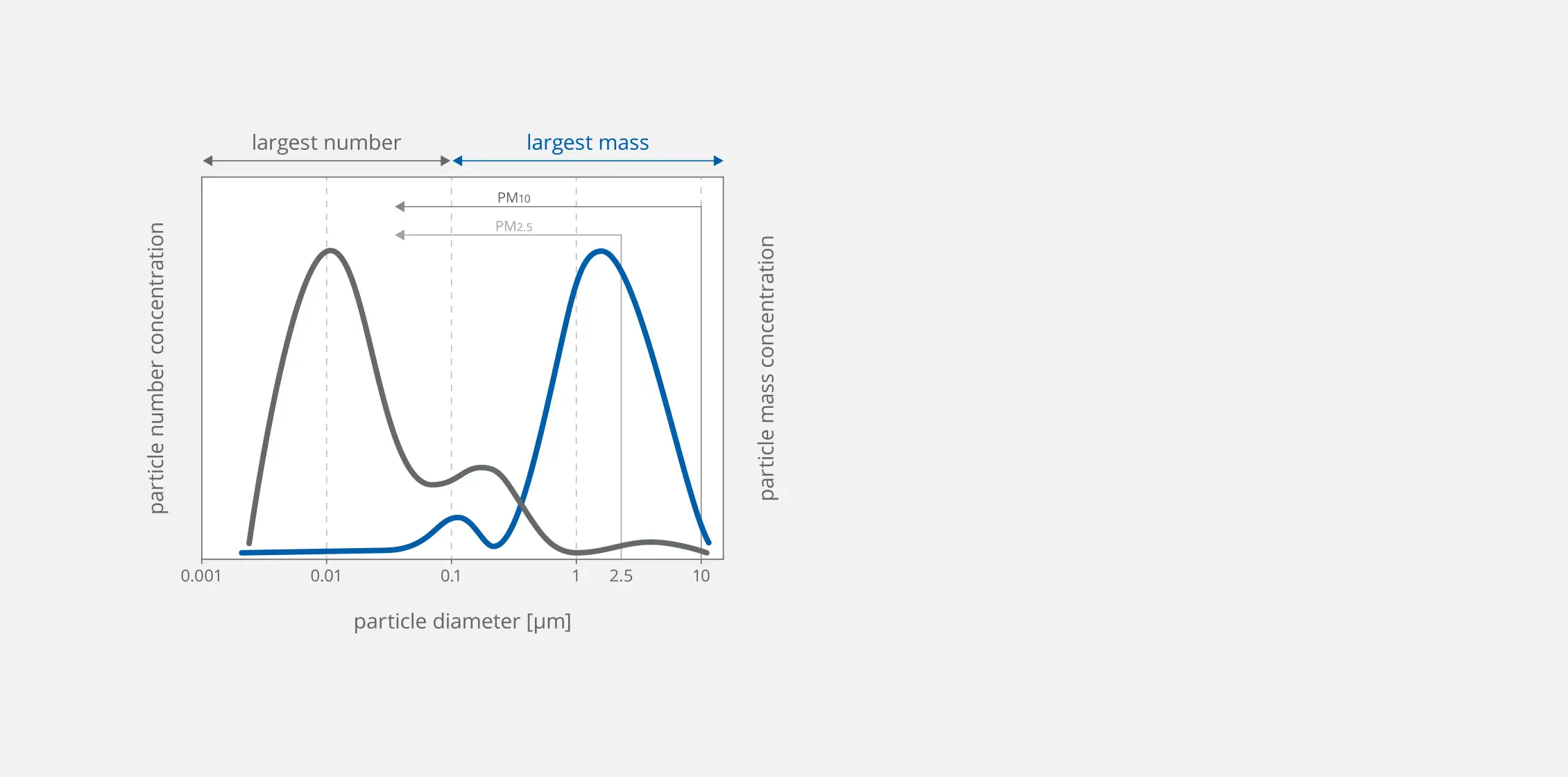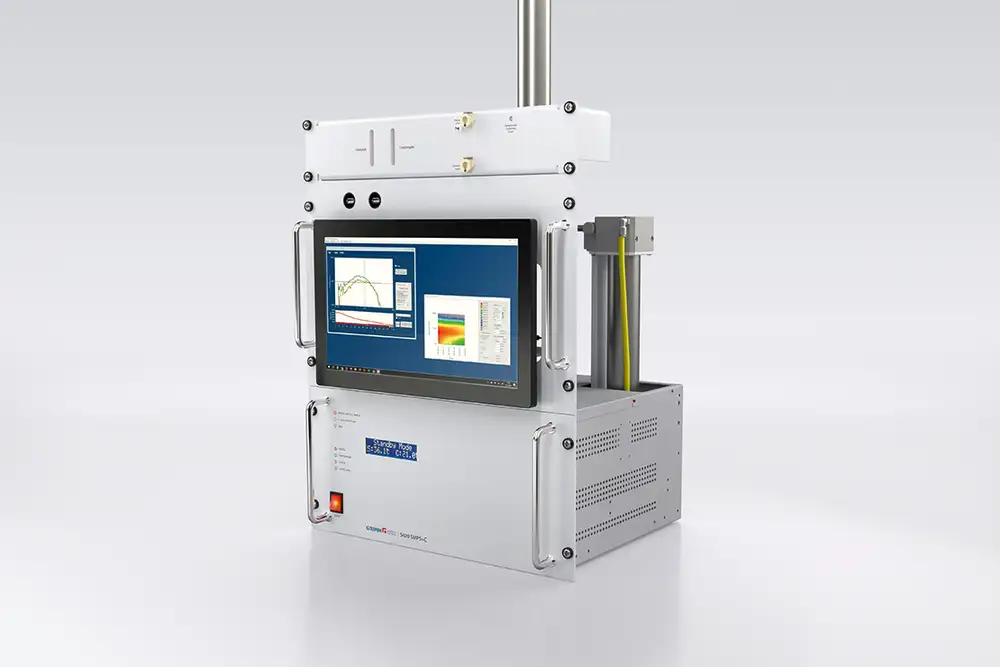
- Solutions
- Industries and Applications
- Air Monitoring Networks
Measuring solutions for air monitoring networks
The DURAG GROUP combines particle and gas measurement under one roof and offers operators of air monitoring networks the symbiosis of both measurement worlds. Only with high-resolution measurement values can monitoring networks react promptly to events, take immediate measures to keep the air clean and develop long-term plans. Our particulate matter measuring devices and gas analyzers provide high-precision data in real time and thus support air monitoring networks in identifying the sources and polluters of air pollutants and initiating measures against them. Here we give you an overview of our systems for measuring and official monitoring of air quality.
Our contribution to compliance with limit values for air pollutants
Air monitoring networks are used for the continuous monitoring of the applicable limit values for air pollutants. The defined limit values aim to reduce harmful effects on human health and the environment and to prevent them through countermeasures. The measurement of current concentrations of particulate matter and ultrafine particulate matter as well as gaseous pollutants therefore makes an important contribution to health and climate protection.
Measurement solutions from the DURAG GROUP actively contribute to the implementation of the mandatory limit values. Our specialists cover a wide range of measurement solutions for air pollutants:
- GRIMM AEROSOL TECHNIK is one of the world's most renowned companies for air quality measurements and offers state-of-the-art systems for measuring particle size distribution, all PM values, occupational health and safety limits and ultrafine particles (UFP).
- AP2E specializes in the analysis and continuous monitoring of gases using highly sensitive laser measurement techniques.
Our measuring range: from gas to large aerosols
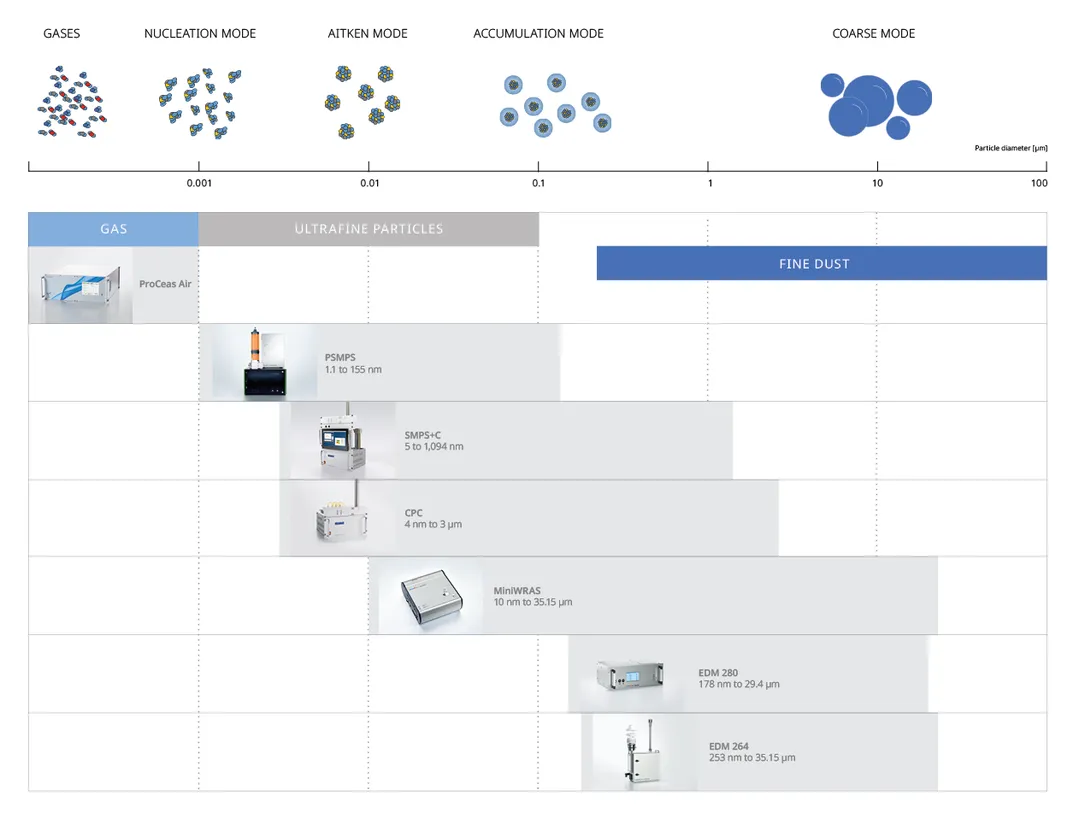
ProCeas Air

PSMPS
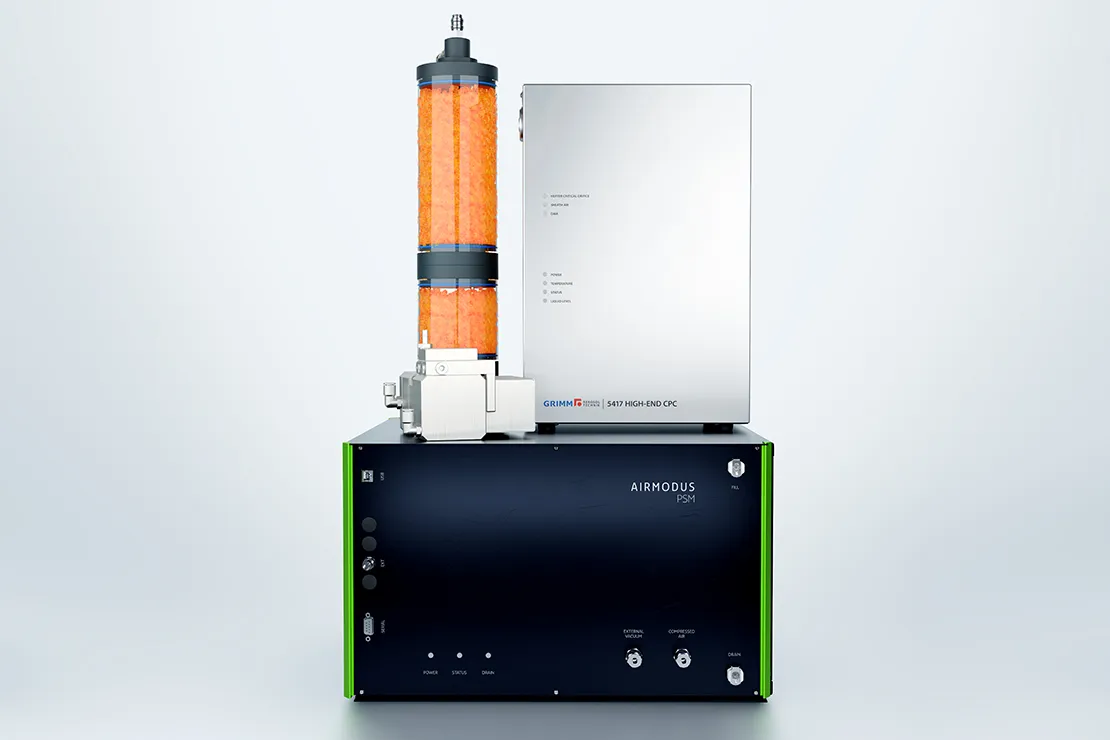
SMPS+C

CPC

MiniWRAS
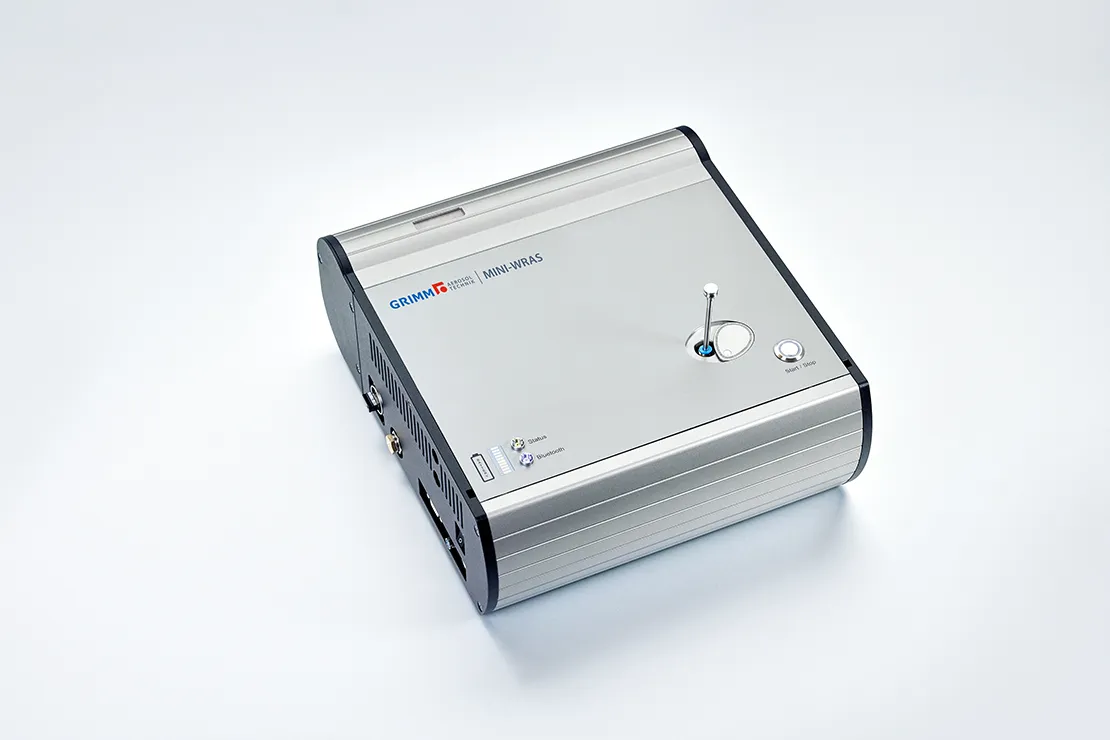
EDM 280
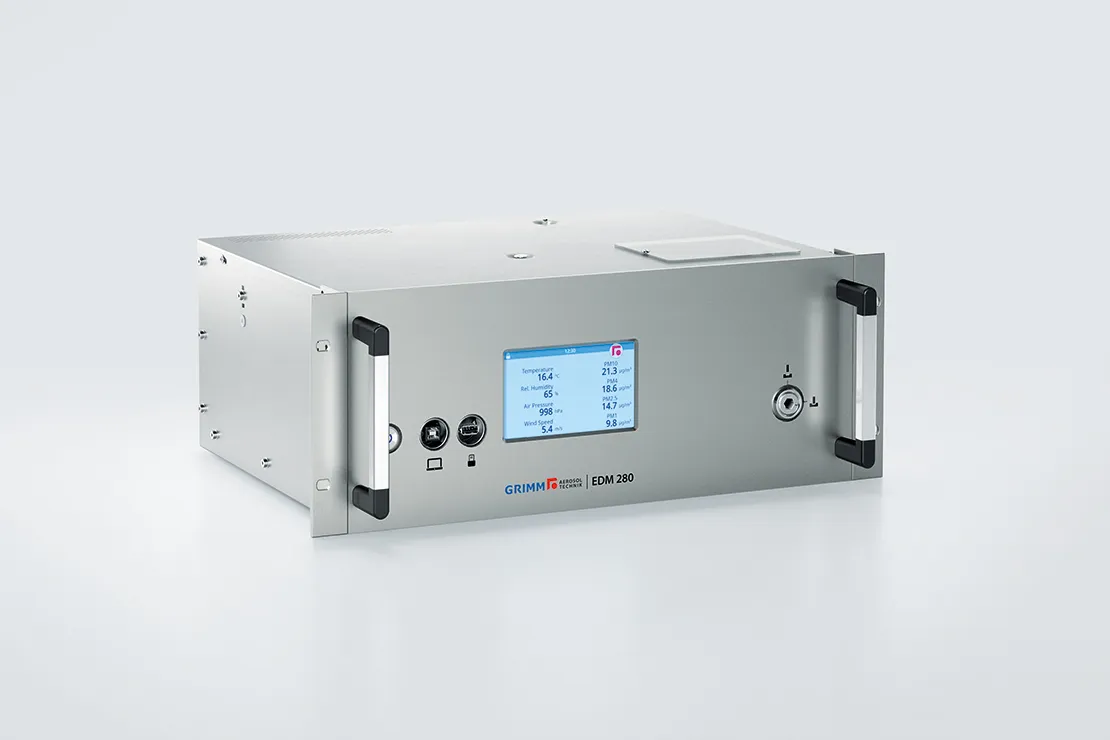
AirQualifier EDM 264

Different air pollutants require different measurement methods. The DURAG GROUP offers highly precise and sensitive measurement technology tailored to the pollutant to be measured. Various gas components in the ambient air are detected by the ProCeas optical gas measuring device, which is based on OFCEAS technology (Optical Feedback Cavity Enhanced Absorption Spectroscopy). From the smallest particle range of nanoclusters (around 1 nanometer), however, the measurement technology from GRIMM AEROSOL TECHNIK is ideal.
The measuring technology for UFP measurements is CEN-compliant and available as a stand-alone measuring device in its own weatherproof housing or as a 19-inch adapter for use in air quality measuring stations. In addition to the pure counting of nanoparticles with a CPC (Condensation Particle Counter), a size-resolving device solution is also available, the so-called SMPS+C. The EDM 280 optical environmental dust monitor is used to measure particulate matter pollution in the environment, in particular the applicable limit values for PM10 and PM2.5. Certified in accordance with EN 16450, it is the most accurate particulate matter monitor in its class worldwide. With a time resolution from 1 minute, it meets the strict approval criteria for use in official measurement tasks.
In addition to the measuring devices typically used for official measurements, the DURAG GROUP offers other solutions, such as the hand-held DustDecoder 11-D fine dust measuring device, various wide-range aerosol spectrometers, such as the battery-operated and hand-held MiniWRAS, the EDM 665 supersite research measuring device or mobile dust measuring devices with their own weatherproof housing, such as the EDM 264.
Measuring locations and sources of air pollutants
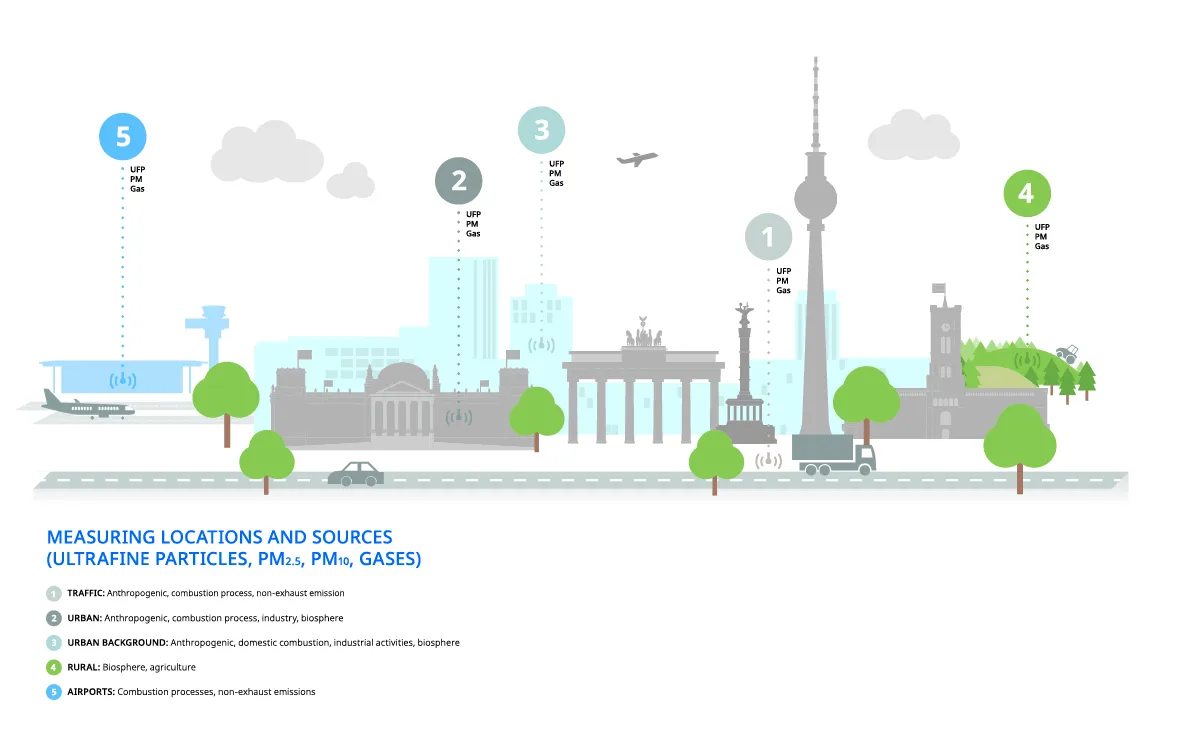
Measuring technology for ultrafine particles

Measuring technology for particulate matter

Gas analyzer ProCeas Air

Environmental agencies have the task of ensuring clean air. It is important and also required by law to measure the current air pollution levels at certain measuring points and thus help the population everywhere to achieve healthy air through appropriate measures. The graphic above shows an air monitoring network with its typical measuring points and tasks. These include traffic-related aerosol measurements on busy roads, urban backgrounds (e.g. housing estates that are not located on main traffic arteries but are nevertheless in the city), rural areas with agriculture and special sources such as airports.
All of these measuring points have different pollutant characteristics and pollution levels. While the measuring points close to traffic are characterized by combustion aerosols and non-exhaust emissions (i.e. all aerosols that originate from traffic but do not come from the exhaust, such as brake abrasion, tire abrasion, road abrasion, etc.), in rural areas we tend to find natural sources from agriculture and nature (pollen, farmland, semi-volatile components, etc.). Each of these measuring locations has its own profile and the DURAG GROUP has suitable measuring devices from GRIMM AEROSOL TECHNIK and AP2E for all tasks.
Measurement of aerosols in the air monitoring network
Environmental agencies have the task of ensuring clean air. It is important and also required by law to measure the current air pollution levels at certain measuring points and thus help the population everywhere to achieve healthy air through appropriate measures. The graphic above shows an air monitoring network with its typical measuring points and tasks. These include traffic-related aerosol measurements on busy roads, urban backgrounds (e.g. housing estates that are not located on main traffic arteries but are nevertheless in the city), rural areas with agriculture and special sources such as airports.
All of these measuring points have different pollutant characteristics and pollution levels. While the measuring points close to traffic are characterized by combustion aerosols and non-exhaust emissions (i.e. all aerosols that originate from traffic but do not come from the exhaust, such as brake abrasion, tire abrasion, road abrasion, etc.), in rural areas we tend to find natural sources from agriculture and nature (pollen, farmland, semi-volatile components, etc.). Each of these measuring locations has its own profile and the DURAG GROUP has suitable measuring devices from GRIMM AEROSOL TECHNIK and AP2E for all tasks.
Measurement technology for particulate matter
Environmental agencies have been operating networks of measuring stations for many decades in order to monitor the dust pollution of the population and decide on countermeasures to reduce particulate matter based on these findings. Various methods are used, including gravimetric and optical particulate matter measurement.
Gravimetric particulate matter measurement
Gravimetric filter samplers with a size-selective inlet head are one method of dust measurement. An air flow is sucked through an inlet head that only allows a certain particle size to pass through and is then passed through a filter. This filter separates all particles and is typically balanced after 24 hours. By combining air volume per unit of time and particle inlet size, it is finally possible to determine how much mass in micrograms per cubic meter was present as an average value as airborne particle mass over an entire day. The process of obtaining the daily mean value, for example PM10, can take around three to five days.
The advantage of this measurement is the direct mass weighing. In addition, the gravimetric measurement principle is regarded as a reference method for other measurement procedures. The disadvantage is the time delay and the loss of a temporal resolution greater than 24 hours. A filter sampler can therefore not provide any information as to whether high levels of particulate matter only occur at the measurement location in the morning and evening, for example due to rush hour traffic, and whether the air was very clean before, in between and after, or whether there is continuous pollution.
However, this time-resolved information is key to developing suitable countermeasures to reduce particulate matter. Because only if the polluters are identified can targeted measures be planned.
Optical particulate matter measurement
This is where GRIMM AEROSOL TECHNIK comes in: With its approved measuring devices for environmental dust measurement by official air monitoring networks, the measured value resolution can be freely selected between six seconds and 24 hours. From a measuring interval of just one minute, the EDM 280 particulate matter measuring device outputs approved PM10 and PM2.5 particulate matter measurement values in accordance with EN16450 and QAL1 - EN15267. With this certified time resolution, the EDM 280 is the best measuring device in its class.
However, the trend in recent years shows that particulate matter levels in large parts of Europe are in the single-digit microgram range. This is a positive development for people's health, as everyone has the right to breathe clean air. At the same time, it places increased demands on the sensitivity of measuring devices.
In addition to the high temporal resolution, which enables precise identification of the fine dust sources, the EDM 280 measuring device offers maximum sensitivity even at low concentrations due to its optical measuring method using a laser, unlike other measuring methods. Filter samplers require mass values in the two-digit microgram range for the best possible performance. However, this presents the collectors with the challenge of continuing to deliver correct results during filter weighing.
Our measuring devices, including the EDM 280 and EDM 264, are the only optical measuring devices on the market that detect, count, classify and output each particle as a mass. The EDM 280, for example, measures each individual particle, divides it into a size class and determines the mass in micrograms per cubic meter using various densities.
Authorities, state offices and environmental agencies use the tested and approved EDM 280 particulate matter measuring device because of its reliability, precision, real-time data retention and cost-effective measuring operation: in standard operation, the EDM 280 only requires 25 watts. Nowadays, this is an important factor for environmental and climate protection. In addition, the EDM 280 environmental dust monitor is free of consumables and requires only minimal maintenance. With its aerosol measuring devices, GRIMM AEROSOL TECHNIK therefore offers the best solution for continuous operation in the air monitoring network.
We use a third party service to embed video content that may collect data about your activity. Please review the details and accept the service to watch this video.
Overview PM monitors

AirQualifier EDM 264Mobile PM monitor
This mobile aerosol spectrometer determines dust mass fractions and particle number size distribution. It is designed for both short and long-term continuous monitoring of dust pollution and enables real-time data analysis of particle number, dust mass and meteorological data.

AirQualifier EDM 264-SVCMobile PM & SVC monitor
This mobile aerosol spectrometer determines dust mass fractions and particle number size distribution without semi-volatile compounds. It is designed for both short and long-term continuous monitoring of dust pollution and enables real-time data analysis of particle number, dust mass and meteorological data.

DustDecoder 11-DPortable aerosol spectrometer
Precise and compact aerosol spectrometer for the determination of dust mass fractions and particle number size distribution. Optimal solution for reliable and flexible real-time measurements for aerosol research and indoor air quality.

EDM 280Environmental dust monitor for PM monitoring in ambient air
Latest generation optical aerosol spectrometer with unique detection limit and excellent counting efficiency. Suitable for real-time PM monitoring under any environmental conditions and at all sites.

EDM 365PM monitoring station
This stand-alone environmental dust monitor detects airborne particles in real time without the loss of the semi-volatile compounds. It is designed for mobile industrial use and allows simultaneous measurement of the dust mass fractions PM10, PM2.5, PM1 and also the particle size distribution in 31 size channels.

EDM 365-SVCSVC & PM research station
This stand-alone environmental dust monitor detects airborne particles in real time, including semi-volatile compounds thanks to its dual sampling system. It allows simultaneous measurement of the dust mass fractions PM10, PM2.5, PM1 and also the particle size distribution in 31 size channels.

EDM 465Ultra-fine-particle counter
CPC in mobile weather-proof housing, designed for 24/7 nanoparticle counting. Different calibrations possible, e.g. for real-time monitoring of UFP in ambient air according to CEN draft standard prEN 16976:2023.
Measuring technology for ultrafine particles
We apply the same standards to UFP : precision, high temporal resolution and quality. Measuring ultrafine particles is a metrological challenge that only a few manufacturers can accomplish with sufficiently high data quality.
Health hazards due to nanoparticles
UFP - also known as nanoparticles - are defined by their size range, which is 100 nanometers (nm) and smaller. Here, mass is less important, even though the highest UFP concentrations can contribute to mass, but rather the hazardous impact on public health. The larger a particle is, the more likely it is to be deposited in the upper respiratory tract by mucous membranes, cilia and other protective mechanisms in the body. However, the smallest nanoparticles reach the bronchioles of the lungs. There, UFP can reach the bloodstream. We are talking here, for example, about fresh soot aerosol from exhaust fumes.
The smallest particles pose the greatest health risk
While the official limit values in air quality measurement have always been mass-related, for example 50 µg/m³ for the PM10 mass fraction and 25 µg/m³ for the PM2.5 mass fraction in the EU, the impact on health, as can be seen in the above diagram, is not determined by mass. Rather, the health risk is defined by whether aerosols can penetrate deep enough into the body so that they reach the lungs, then the alveoli and finally even the bloodstream.
The smallest particles, the UFP range, are almost massless and contribute almost no mass even in the largest numbers. However, this is the aerosol fraction that is present in the highest numbers. This means that the most dangerous particles cannot be detected by the current limit value measurements, but are of much greater relevance for the task of all monitoring networks: the protection of human health.
The diagram below shows the typical ratio of particle reality: While very few large particles make up the largest mass, most aerosols are present in the ultrafine range. Large particles are largely excreted in the nasopharynx and thorax, so they do not enter the lungs and are also excreted by coughing or sneezing. However, UFP can be absorbed very effectively by the body and pose a greater health risk. Therefore, the measurement of nanoparticles is of utmost importance.
Progress in nanoparticle measurement
As nanoparticles hardly contribute to the mass and are difficult to measure, the measurement of nanoparticles has not been widespread in recent decades. The established limit values were previously mass-based, i.e. there was a maximum permitted upper limit measured in micrograms per cubic meter (µg/m³) for PM10 and PM2.5. The progressive development of measurement technology allowed more in-depth research, which in turn demonstrated the need to include nanoparticles in the environment, which are highly hazardous to health. This also led to the World Health Organization officially recommending the measurement of nanoparticle concentrations in outdoor air for the first time in 2021 for the purpose of health protection.
In the meantime, a European standard has been established according to which the measurement technology must provide a defined performance regardless of the location of use and thus deliver comprehensible and verifiable results. The nano measurement technology from GRIMM AEROSOL TECHNIK includes condensation particle counters (CPC) and size-resolving nanoparticle measuring devices, so-called scanning mobility particle sizers and counters (SMPS+C). GRIMM AEROSOL TECHNIK is also the only manufacturer to offer CEN-compliant (European Committee for Standardization) UFP measuring instruments both for bench-top laboratory set-ups and for environmental monitoring network installations in 19-inch racks.
Our condensation particle counters CPC comply with prEN 16976:2023; the mobility particle size spectrometers SMPS+C comply with CEN/TS 17434:2020.
GRIMM nanoparticle measuring devices meet important standards
UFP measurements are becoming increasingly important, which is why international harmonization of commercially available measuring devices is necessary to ensure the precision of hazardous nanoparticle measurements.
- CEN/TS 17434:2020
Ambient air - Determination of the particle number size distribution of atmospheric aerosol using a mobility particle size spectrometer (MPSS) - prEN 16976:2023
Ambient air - Determination of particle number concentration of atmospheric aerosol - ACTRIS
ACTRIS is the pan-European research infrastructure that provides high quality data and information on short-lived atmospheric constituents and the processes that lead to the variability of these constituents in natural and controlled atmospheres. The CPC, SMPS+C and PSMPS measuring instruments from GRIMM AEROSOL TEHCNIK meet the high calibration standard of the specifications and are therefore officially suitable for use in ACTRIS measuring stations.
We use a third party service to embed video content that may collect data about your activity. Please review the details and accept the service to watch this video.
Overview UFP monitors

CPC 5421 | 5421-TR-CEN19" condensation particle counter
CPC in 19” rack design available as model 5421-TR-CEN with a D50 of 10 nm for full compliance with the EN16976 for 24/7 real-time monitoring of UFP in ambient air, or the standard calibrated model 5421 with a D50 of 4 nm.

EDM 465Ultra-fine-particle counter
CPC in mobile weather-proof housing, designed for 24/7 nanoparticle counting. Different calibrations possible, e.g. for real-time monitoring of UFP in ambient air according to CEN draft standard prEN 16976:2023.

EDM 665 WRASOutdoor wide-range aerosol spectrometer
Aerosol spectrometer covering the particle size range from 5 nm … 32 μm. The weather-protected instrument is designed especially for atmospheric monitoring and combines two technologies: SMPS+C for nanoparticles and EDM 180 for micron-sized aerosol.

MiniWRAS 1371Portable wide-range aerosol spectrometer
The only portable instrument on the market that allows simultaneous and precise real-time monitoring of both micron-sized and nanoparticles. Designed for indoor air quality monitoring.

PSMPSNano mobility particle size spectrometer
The PSMPS is a mobility particle size spectrometer with a 2-stage condensation particle counter detection system for delving into the sub-2-nm size range. It combines a Grimm SMPS+C system with the Airmodus Particle Size Magnifier (PSM).

SMPS+CScanning mobility particle sizer
Scanning mobility particle sizer with condensation particle counter. This is a versatile all-in-one solution for precise nanoparticle counting and sizing and can be combined with a GRIMM dust monitor in order to create a wide-range aerosol spectrometer. Also available as 19-inch variant.

SMPS+C 5420 | 5420-TR-CEN19" scanning mobility particle sizer and counter
SMPS+C system in 19” rack-design, available as model 5420-TR-CEN with a size range of 10 nm to 1,090 nm for full compliance with CEN/TS 17434:2020 or as model 5420 version with M DMA for a size range of 5 nm to 350 nm. It is designed for unattended 24/7 real-time monitoring of UFP in ambient air.

SMPS+EScanning mobility particle sizer
Scanning mobility particle sizer with Faraday cup electrometer. This is an all-in-one system for particle size distribution and can also be used as referencing instrument for calibration of nanoparticle counters since it is optimized to reduce the effects of mechanical shocks and pressure differences.
Measurement of gases in air monitoring networks
Monitoring networks are also legally obliged to measure gaseous air pollutants. These primarily include nitrogen oxides, sulphur dioxide and ozone.
However, the air pollutant ammonia is also becoming increasingly important, as it is emitted in large quantities by agriculture and forms aerosols such as ammonium nitrate and ammonium sulphate in the atmosphere.
With the ProCeas Air, AP2E has a measuring device that is ideally suited for measuring these gaseous air pollutants in monitoring networks. It is based on the patented OFCEAS technology and is designed as an extractive measuring system.
Case studies on monitoring air quality

Air Quality Monitoring Network Berlin

Fine Dust Measurement in the „Green Port“ of Koper

Atmospheric Research Project: Effects of the Climate Change

Aerosol and gas measurement above the clouds

Aerosol Measurement on the Research Vessel METEOR

EUREC4A
FAQs on air quality monitoring in monitoring networks
Air quality monitoring is crucial for understanding the impact of air pollution on human health and the environment. It also enables authorities to take appropriate measures to improve air quality and ensure compliance with environmental regulations.
An air quality monitoring network (also known as an air quality monitoring network) consists of a series of sensors and measuring devices that are set up at strategic locations. These instruments continuously collect data on the concentration of air pollutants. The data is transmitted to a central database where it is analyzed and made available to the public.
The results of the air quality measurements are often published in real time via online platforms, mobile applications or public announcements. The authorities inform the public about the current air quality and issue recommendations or warnings if necessary.
Air monitoring networks play a crucial role in improving air quality. Here are some important aspects of how air monitoring networks contribute to positive changes in air quality:
- Early detection of air pollutants: Air monitoring networks enable continuous monitoring of air pollutants at different locations. Early detection of increased pollutant concentrations allows authorities to react quickly to minimize potential health risks.
- Information basis for decision-makers: The data collected by the air monitoring networks provides decision-makers with a sound basis for developing guidelines and measures to protect the environment. Political decisions can thus be made on a scientific basis in order to promote a targeted improvement in air quality.
- Monitoring of emission sources: Air monitoring networks help to identify and monitor specific emission sources. This allows industries or modes of transport responsible for high levels of pollution to be identified and targeted measures to reduce emissions to be taken.
- Public participation and awareness-raising: By publishing air quality data in real time, air monitoring networks can raise public awareness. Citizens are encouraged to actively participate in environmental protection measures and change their lifestyles to improve air quality.
- Long-term trend analysis: Air monitoring networks make it possible to analyze long-term trends in air pollutants. This is important to evaluate the effectiveness of environmental protection measures and make adjustments to achieve long-term environmental goals.
- International cooperation: By standardizing measurement methods and data formats, air monitoring networks also enable cooperation and data exchange on an international level. This is important as air pollution often has transboundary effects.
- Monitoring industrial and traffic emissions: Air monitoring networks play a central role in monitoring industrial and transportation emissions. This allows emission sources that contribute particularly to high pollutant concentrations to be identified and appropriate measures to reduce emissions to be taken.
Overall, air monitoring networks help to make informed decisions, improve air quality, minimize health risks and achieve long-term environmental goals. They are an essential part of a comprehensive environmental monitoring system.
Continuous measurement methods with high-resolution measurement values enable real-time analysis of data. This permanent monitoring enables air monitoring networks to react quickly to changes, take immediate measures to keep the air clean and develop long-term plans to improve air quality.
Optical particulate matter measurement uses laser or light scattering techniques to detect particles in the air and determine their concentration. This method offers a high temporal resolution and enables the fine dust concentration to be recorded quickly. It is well suited for continuous measurements and can detect a wide range of particle sizes.
In gravimetric particulate matter measurement, the particles are collected on a filter and the increase in weight of the filter is measured. This method requires a longer data acquisition time and offers a lower temporal resolution than optical measurement. However, it is often regarded as a reference method and provides accurate mass values for particulate matter.
Overall, both methods have different advantages and disadvantages and can be used depending on the requirements of the specific application.
The DURAG GROUP offers high-precision measuring devices for fine dust and ultrafine particles as well as gas analyzers that support air monitoring networks in identifying sources and polluters of air pollutants and taking measures against them.

